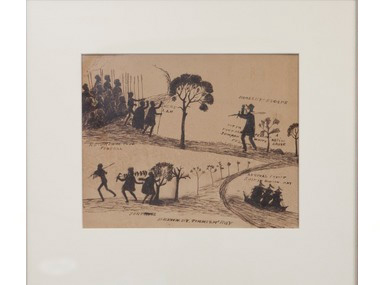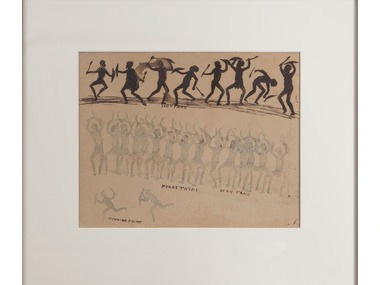THE CONVICT PORTRAYED BY AN ABORIGINE

Buckley's Escape by Tommy McRae, 1890s, pen and ink on paper 24.0 x 30.0 cm, photography: Jason McCarthy, NMA
Posted by Jeremy Eccles | 27.04.12
Gallery: National Museum of Australia
Dates:
23.04.12
At a generally unhappy auction of Aboriginal art on 4th April at the house of Deutscher + Hackett, the National Museum of Australia swooped on two 19th Century drawings by the Kwatkwat artist, Tommy McRae. For $79,300 – a record price for the artist - they came away with Buckley’s Escape, a quasi-comic strip picture of the convict, William Buckley, who tired of convict life before he'd even arrived in Melbourne in the early 1800s and escaped to spend 32 years of his life in the bush with the Wathurung clan
The story of Buckley, known as the ‘Wild White Man’, achieved mythical status in the new colony of Victoria and was discussed in books, pamphlets and newspaper reports throughout the century. Having been transported to the colonies for life, Buckley absconded from the sailing vessel Calcutta when it anchored at Port Philip. An account of his first meeting with local people describes how Buckley, after struggling for a time in the bush without food or water, came across a native grave. Commandeering a spear that was protruding from the grave site to use as a walking stick, Buckley soon encountered local people, who believed him to be the re-incarnation of the owner of the spear and readily accepted him into their community. Buckley subsequently learnt the language and customs, actively participating in Aboriginal life for three decades before giving himself up to a party of European surveyors in 1835.
Buckley’s Escape is the first work detailing the William Buckley story to appear at auction, though the subject matter is one McRae addressed in many other works. This particular example is significant because it depicts multiple episodes from the Buckley story.
Adding further value is the excellent provenance which begins with the purchase of the work directly from the artist in the 1890’s by Mr. John Guthrie-Gray, a Scottish émigré and landholder in the Corowa district, and continues through the family by descent to the current owner – the buyer's great grandson.
Born in 1835, Tommy McRae spent most of his life on the middle reaches of the Murray River along the New South Wales and Victorian border. Along with William Barak, he was one of the best known Aboriginal artists working at that time. Also known as Yakaduna, his preferred medium was drawing, usually pen and ink on paper, primarily in sketchbooks, sometimes on loose sheets, observing aspects of traditional Aboriginal life and early colonial settlement. The drawings produced by McRae were made at a time when life around him was changing dramatically. His later years were spent in the Corowa/Wahgunya area on the Aboriginal reserve established at Lake Moodemere, where McRae set up a family camp. It was there that the majority of his drawings were produced.
The earliest documented collection of his drawings date from the early 1860s, at which time the artist was described as working as a stockman for pastoralists in the upper Murray region and his sketchbooks include drawings of pastoralists and their homesteads. McRae possessed an extensive knowledge of the traditional lifestyle of his people as evidenced in his drawings of hunting, fishing, warfare and ceremonial dances. His drawings are described by NMA Director, Andrew Sayers in his Aboriginal Artists of the Nineteenth Century as ‘distinctive in the use of the silhouette. It is an art of extreme economy but for all its reductiveness... is highly expressive’.
As Carol Cooper concludes in her monograph, Aboriginal History, Tommy McRae was ‘a gifted man with extraordinary talent who, in spite of a lifetime of great hardship which saw the destruction of his people and the separation of his family, maintained a sense of dignity and ironic humour which won the admiration of all who knew him, Aborigines and Europeans alike’.
URL: www.nma.gov.au
Share this:
»  del.icio.us
»
del.icio.us
»  Digg it
»
Digg it
»  reddit
»
reddit
»  Google
»
Google
»  StumbleUpon
»
StumbleUpon
»  Technorati
»
Technorati
»  Facebook
Facebook
Contact Details
Gallery: National Museum of Australia
Email: information@nma.gov.au
Telephone: +61 2 6208 5000
Address: Lawson Crescent Acton Peninsula Canberra 2600 ACT
Gallery: National Museum of Australia
Email: information@nma.gov.au
Telephone: +61 2 6208 5000
Address: Lawson Crescent Acton Peninsula Canberra 2600 ACT

Murry Tribe Warfare by Tommy McRae, 1890s, pen and ink on paper 22.0 x 34.0 cm, photography: Jason McCarthy, NMA
Where is the exhibition?
Further Research
Gallery: National Museum of Australia
Artists: Tommy McRae | William Barak
News Tags: Deutscher + Hackett | National Museum of Australia | Tommy McRae | William Buckley
News Categories: Auction | Australia | Blog | Exhibition | News
Exhibition Archive
- 10.10.17 | TARNANTHI 2017
- 11.08.17 | Natsiaas 2017
- 20.07.17 | APY ART DOMINATES THE WYNNE
- 17.07.17 | Anangu Artist Wins $100,000 Prize
- 14.07.17 | The End of AAMU
- 11.07.17 | ART ACROSS THE COUNTRY
- 11.07.17 | TARNANTHI IN OCTOBER
- 05.07.17 | TJUNGUṈUTJA - from having come together
- 13.06.17 | Ghost-Nets Straddle the World
- 07.06.17 | Grayson Perry Going Indigenous?
- 05.06.17 | Barks Bigger than Ben Hur
- 27.05.17 | NGA QUINQUENNIAL 2017
- 21.05.17 | Blak Douglas Finds Home at the NGA
- 21.05.17 | BRIAN ROBINSON WINS HAZELHURST WOP
- 18.05.17 | PARRTJIMA 2.0
Advertising

